Systems and Statistical Thinking: Histopathology Lab Analysis
VerifiedAdded on 2023/06/07
|16
|4400
|120
Report
AI Summary
This report delves into the application of systems and statistical thinking within the context of a histopathology laboratory. It examines the concept of 'turnaround time' as a key performance indicator, analyzing its impact on patient diagnosis, treatment, and satisfaction. The report explores the concept of emergent properties within a laboratory system, considering the challenges in assessing them due to the intricate nature of the processes involved. It also investigates the use of both quantitative and qualitative methods for evaluating turnaround times. Furthermore, the report discusses the 'Kaizen' managerial policy and its relevance to improving laboratory processes, contrasting process-focused and result-focused management approaches. The report also highlights the importance of statistical thinking in analyzing laboratory data, including numerical data related to cellular and microbial counts, and its role in decision-making processes within the laboratory. The analysis uses examples such as hypothesis testing and the impact of data collection on decision-making related to diagnosis and treatment.
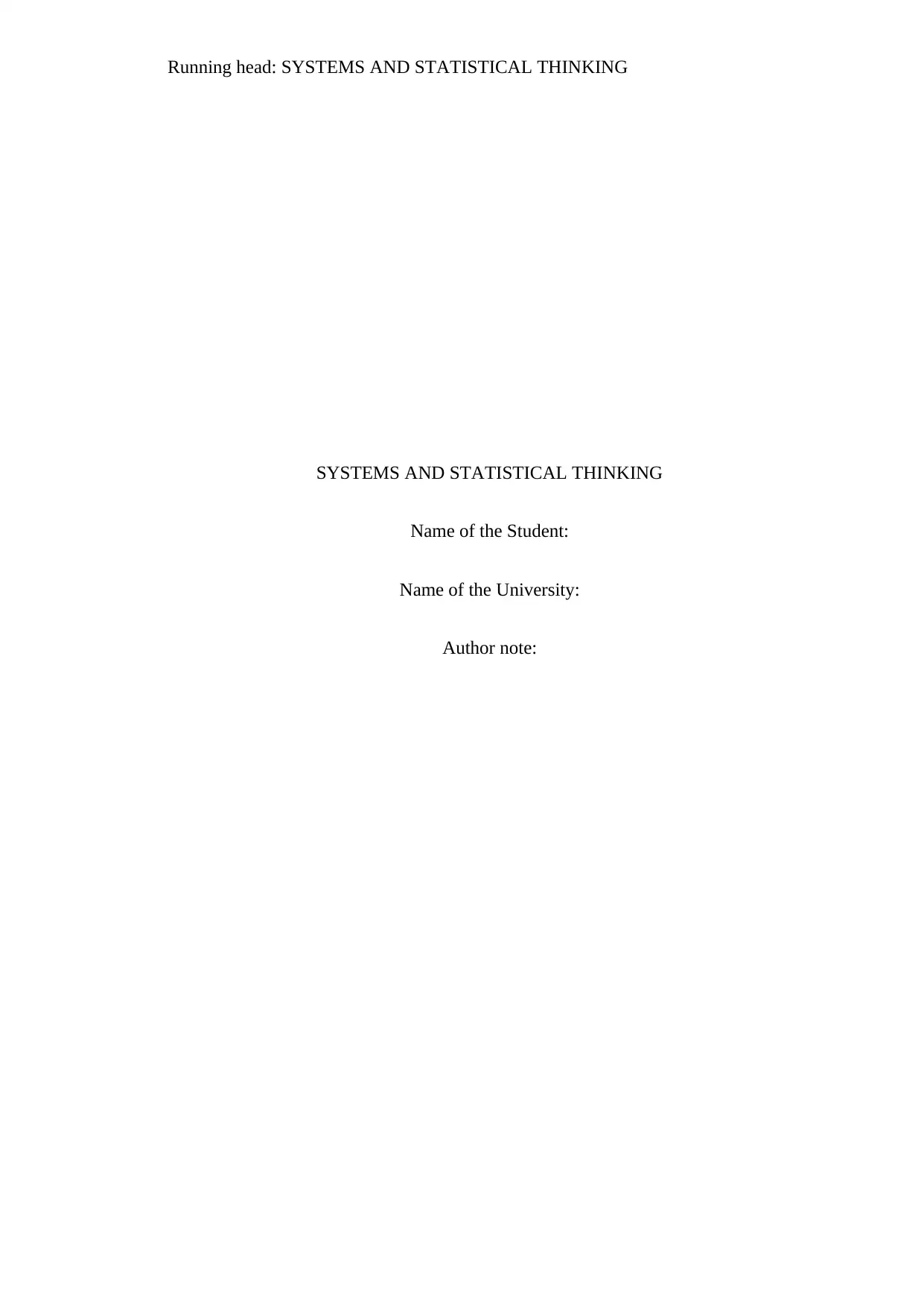
Running head: SYSTEMS AND STATISTICAL THINKING
SYSTEMS AND STATISTICAL THINKING
Name of the Student:
Name of the University:
Author note:
SYSTEMS AND STATISTICAL THINKING
Name of the Student:
Name of the University:
Author note:
Paraphrase This Document
Need a fresh take? Get an instant paraphrase of this document with our AI Paraphraser
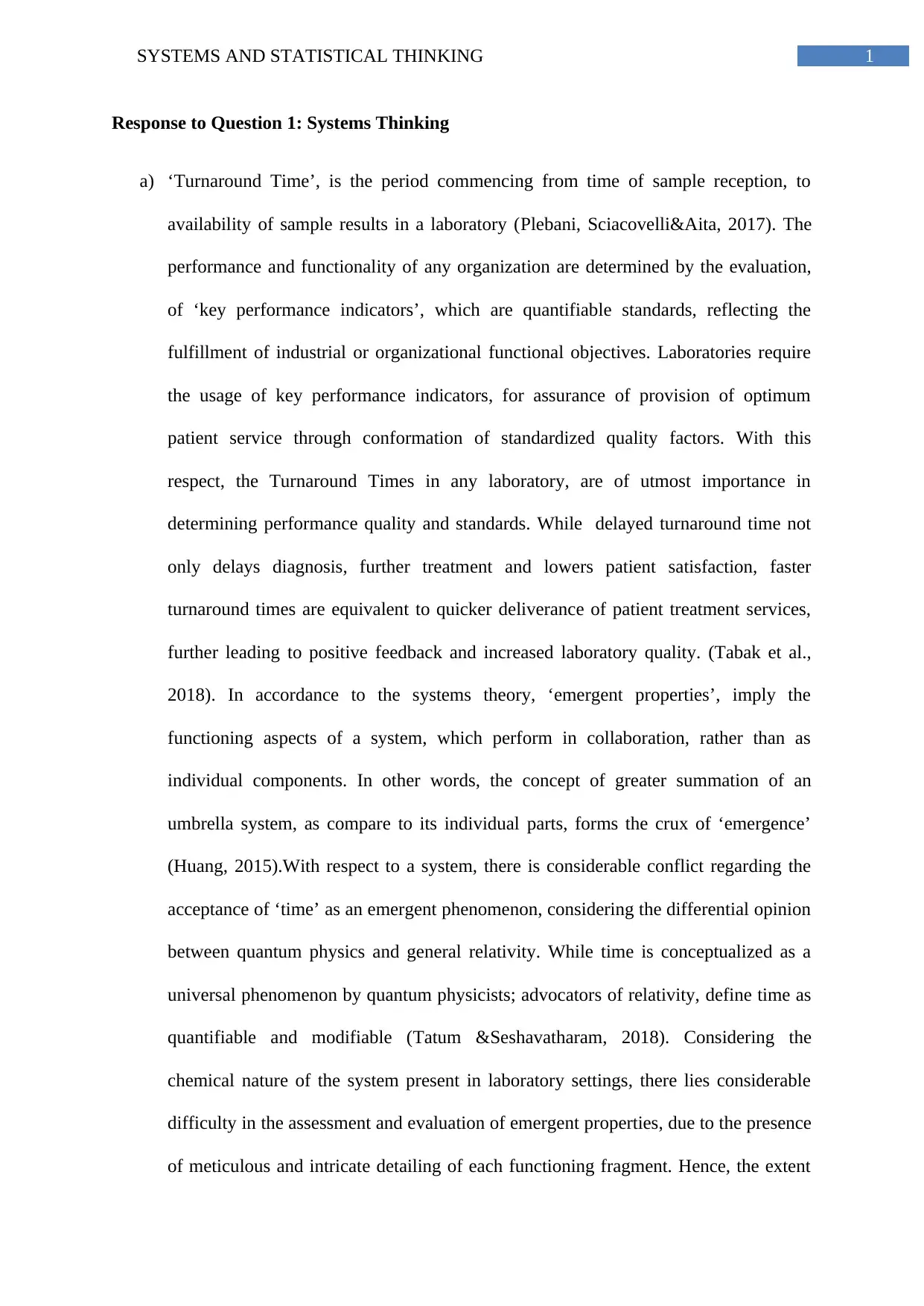
1SYSTEMS AND STATISTICAL THINKING
Response to Question 1: Systems Thinking
a) ‘Turnaround Time’, is the period commencing from time of sample reception, to
availability of sample results in a laboratory (Plebani, Sciacovelli&Aita, 2017). The
performance and functionality of any organization are determined by the evaluation,
of ‘key performance indicators’, which are quantifiable standards, reflecting the
fulfillment of industrial or organizational functional objectives. Laboratories require
the usage of key performance indicators, for assurance of provision of optimum
patient service through conformation of standardized quality factors. With this
respect, the Turnaround Times in any laboratory, are of utmost importance in
determining performance quality and standards. While delayed turnaround time not
only delays diagnosis, further treatment and lowers patient satisfaction, faster
turnaround times are equivalent to quicker deliverance of patient treatment services,
further leading to positive feedback and increased laboratory quality. (Tabak et al.,
2018). In accordance to the systems theory, ‘emergent properties’, imply the
functioning aspects of a system, which perform in collaboration, rather than as
individual components. In other words, the concept of greater summation of an
umbrella system, as compare to its individual parts, forms the crux of ‘emergence’
(Huang, 2015).With respect to a system, there is considerable conflict regarding the
acceptance of ‘time’ as an emergent phenomenon, considering the differential opinion
between quantum physics and general relativity. While time is conceptualized as a
universal phenomenon by quantum physicists; advocators of relativity, define time as
quantifiable and modifiable (Tatum &Seshavatharam, 2018). Considering the
chemical nature of the system present in laboratory settings, there lies considerable
difficulty in the assessment and evaluation of emergent properties, due to the presence
of meticulous and intricate detailing of each functioning fragment. Hence, the extent
Response to Question 1: Systems Thinking
a) ‘Turnaround Time’, is the period commencing from time of sample reception, to
availability of sample results in a laboratory (Plebani, Sciacovelli&Aita, 2017). The
performance and functionality of any organization are determined by the evaluation,
of ‘key performance indicators’, which are quantifiable standards, reflecting the
fulfillment of industrial or organizational functional objectives. Laboratories require
the usage of key performance indicators, for assurance of provision of optimum
patient service through conformation of standardized quality factors. With this
respect, the Turnaround Times in any laboratory, are of utmost importance in
determining performance quality and standards. While delayed turnaround time not
only delays diagnosis, further treatment and lowers patient satisfaction, faster
turnaround times are equivalent to quicker deliverance of patient treatment services,
further leading to positive feedback and increased laboratory quality. (Tabak et al.,
2018). In accordance to the systems theory, ‘emergent properties’, imply the
functioning aspects of a system, which perform in collaboration, rather than as
individual components. In other words, the concept of greater summation of an
umbrella system, as compare to its individual parts, forms the crux of ‘emergence’
(Huang, 2015).With respect to a system, there is considerable conflict regarding the
acceptance of ‘time’ as an emergent phenomenon, considering the differential opinion
between quantum physics and general relativity. While time is conceptualized as a
universal phenomenon by quantum physicists; advocators of relativity, define time as
quantifiable and modifiable (Tatum &Seshavatharam, 2018). Considering the
chemical nature of the system present in laboratory settings, there lies considerable
difficulty in the assessment and evaluation of emergent properties, due to the presence
of meticulous and intricate detailing of each functioning fragment. Hence, the extent
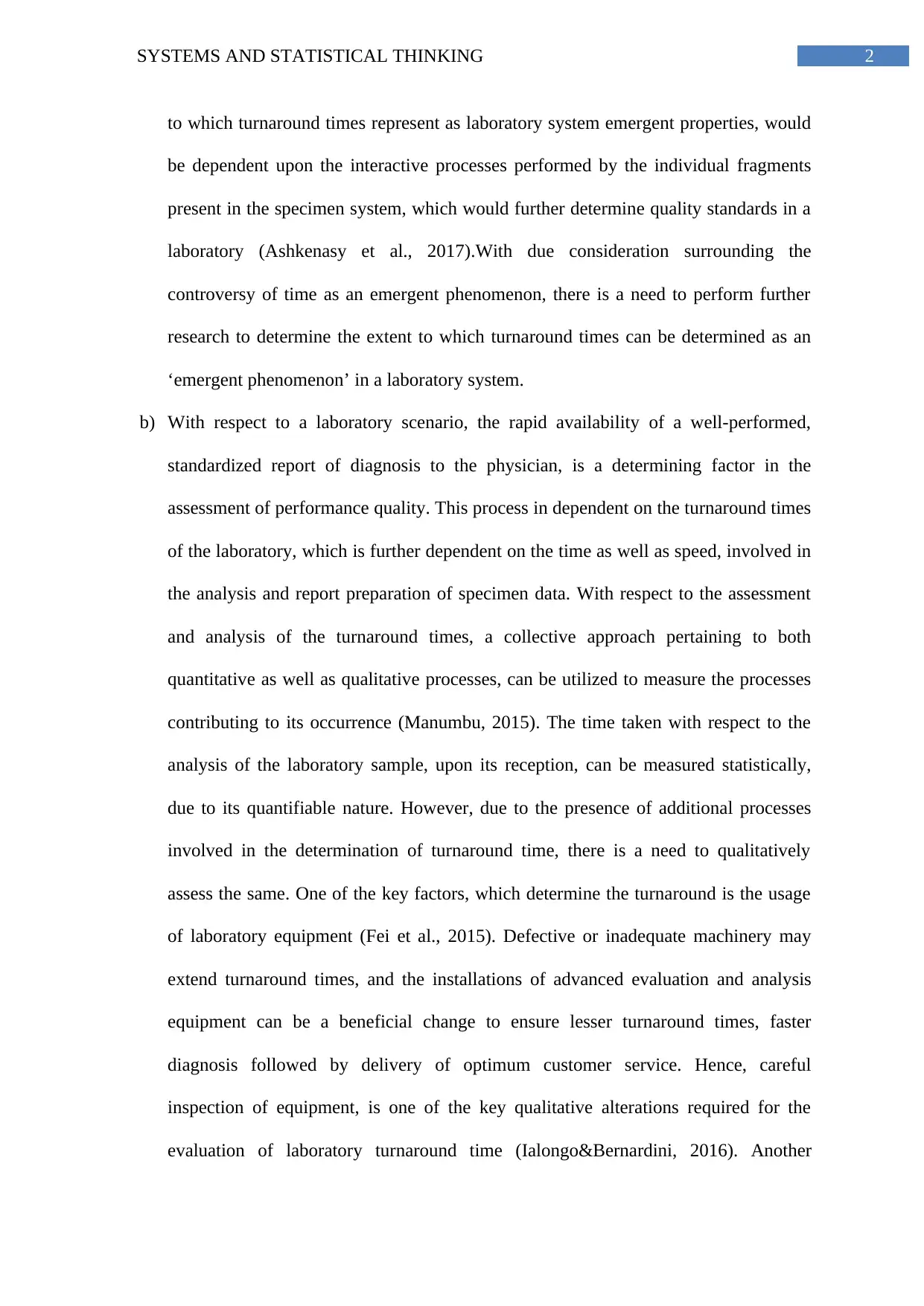
2SYSTEMS AND STATISTICAL THINKING
to which turnaround times represent as laboratory system emergent properties, would
be dependent upon the interactive processes performed by the individual fragments
present in the specimen system, which would further determine quality standards in a
laboratory (Ashkenasy et al., 2017).With due consideration surrounding the
controversy of time as an emergent phenomenon, there is a need to perform further
research to determine the extent to which turnaround times can be determined as an
‘emergent phenomenon’ in a laboratory system.
b) With respect to a laboratory scenario, the rapid availability of a well-performed,
standardized report of diagnosis to the physician, is a determining factor in the
assessment of performance quality. This process in dependent on the turnaround times
of the laboratory, which is further dependent on the time as well as speed, involved in
the analysis and report preparation of specimen data. With respect to the assessment
and analysis of the turnaround times, a collective approach pertaining to both
quantitative as well as qualitative processes, can be utilized to measure the processes
contributing to its occurrence (Manumbu, 2015). The time taken with respect to the
analysis of the laboratory sample, upon its reception, can be measured statistically,
due to its quantifiable nature. However, due to the presence of additional processes
involved in the determination of turnaround time, there is a need to qualitatively
assess the same. One of the key factors, which determine the turnaround is the usage
of laboratory equipment (Fei et al., 2015). Defective or inadequate machinery may
extend turnaround times, and the installations of advanced evaluation and analysis
equipment can be a beneficial change to ensure lesser turnaround times, faster
diagnosis followed by delivery of optimum customer service. Hence, careful
inspection of equipment, is one of the key qualitative alterations required for the
evaluation of laboratory turnaround time (Ialongo&Bernardini, 2016). Another
to which turnaround times represent as laboratory system emergent properties, would
be dependent upon the interactive processes performed by the individual fragments
present in the specimen system, which would further determine quality standards in a
laboratory (Ashkenasy et al., 2017).With due consideration surrounding the
controversy of time as an emergent phenomenon, there is a need to perform further
research to determine the extent to which turnaround times can be determined as an
‘emergent phenomenon’ in a laboratory system.
b) With respect to a laboratory scenario, the rapid availability of a well-performed,
standardized report of diagnosis to the physician, is a determining factor in the
assessment of performance quality. This process in dependent on the turnaround times
of the laboratory, which is further dependent on the time as well as speed, involved in
the analysis and report preparation of specimen data. With respect to the assessment
and analysis of the turnaround times, a collective approach pertaining to both
quantitative as well as qualitative processes, can be utilized to measure the processes
contributing to its occurrence (Manumbu, 2015). The time taken with respect to the
analysis of the laboratory sample, upon its reception, can be measured statistically,
due to its quantifiable nature. However, due to the presence of additional processes
involved in the determination of turnaround time, there is a need to qualitatively
assess the same. One of the key factors, which determine the turnaround is the usage
of laboratory equipment (Fei et al., 2015). Defective or inadequate machinery may
extend turnaround times, and the installations of advanced evaluation and analysis
equipment can be a beneficial change to ensure lesser turnaround times, faster
diagnosis followed by delivery of optimum customer service. Hence, careful
inspection of equipment, is one of the key qualitative alterations required for the
evaluation of laboratory turnaround time (Ialongo&Bernardini, 2016). Another
⊘ This is a preview!⊘
Do you want full access?
Subscribe today to unlock all pages.

Trusted by 1+ million students worldwide
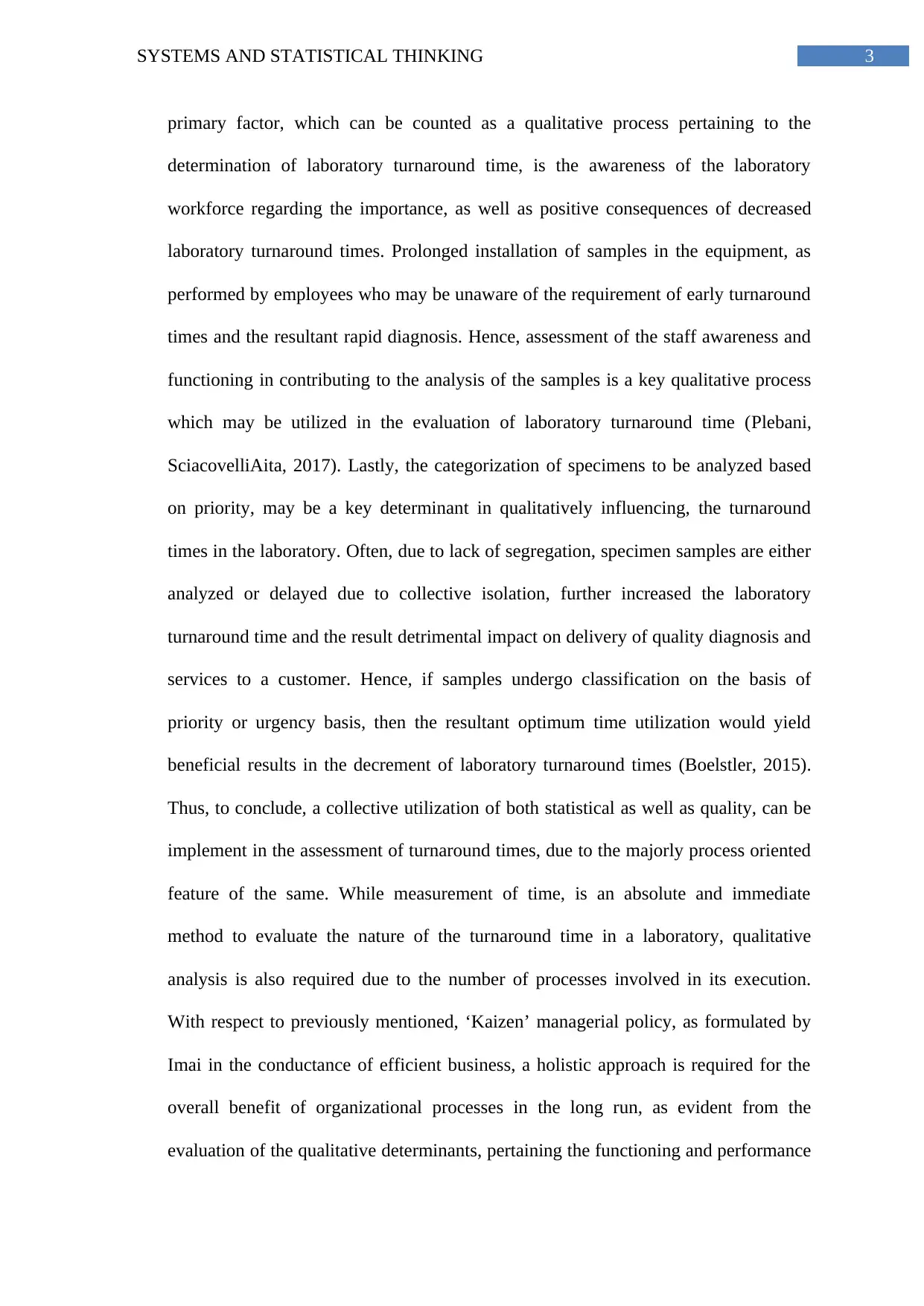
3SYSTEMS AND STATISTICAL THINKING
primary factor, which can be counted as a qualitative process pertaining to the
determination of laboratory turnaround time, is the awareness of the laboratory
workforce regarding the importance, as well as positive consequences of decreased
laboratory turnaround times. Prolonged installation of samples in the equipment, as
performed by employees who may be unaware of the requirement of early turnaround
times and the resultant rapid diagnosis. Hence, assessment of the staff awareness and
functioning in contributing to the analysis of the samples is a key qualitative process
which may be utilized in the evaluation of laboratory turnaround time (Plebani,
SciacovelliAita, 2017). Lastly, the categorization of specimens to be analyzed based
on priority, may be a key determinant in qualitatively influencing, the turnaround
times in the laboratory. Often, due to lack of segregation, specimen samples are either
analyzed or delayed due to collective isolation, further increased the laboratory
turnaround time and the result detrimental impact on delivery of quality diagnosis and
services to a customer. Hence, if samples undergo classification on the basis of
priority or urgency basis, then the resultant optimum time utilization would yield
beneficial results in the decrement of laboratory turnaround times (Boelstler, 2015).
Thus, to conclude, a collective utilization of both statistical as well as quality, can be
implement in the assessment of turnaround times, due to the majorly process oriented
feature of the same. While measurement of time, is an absolute and immediate
method to evaluate the nature of the turnaround time in a laboratory, qualitative
analysis is also required due to the number of processes involved in its execution.
With respect to previously mentioned, ‘Kaizen’ managerial policy, as formulated by
Imai in the conductance of efficient business, a holistic approach is required for the
overall benefit of organizational processes in the long run, as evident from the
evaluation of the qualitative determinants, pertaining the functioning and performance
primary factor, which can be counted as a qualitative process pertaining to the
determination of laboratory turnaround time, is the awareness of the laboratory
workforce regarding the importance, as well as positive consequences of decreased
laboratory turnaround times. Prolonged installation of samples in the equipment, as
performed by employees who may be unaware of the requirement of early turnaround
times and the resultant rapid diagnosis. Hence, assessment of the staff awareness and
functioning in contributing to the analysis of the samples is a key qualitative process
which may be utilized in the evaluation of laboratory turnaround time (Plebani,
SciacovelliAita, 2017). Lastly, the categorization of specimens to be analyzed based
on priority, may be a key determinant in qualitatively influencing, the turnaround
times in the laboratory. Often, due to lack of segregation, specimen samples are either
analyzed or delayed due to collective isolation, further increased the laboratory
turnaround time and the result detrimental impact on delivery of quality diagnosis and
services to a customer. Hence, if samples undergo classification on the basis of
priority or urgency basis, then the resultant optimum time utilization would yield
beneficial results in the decrement of laboratory turnaround times (Boelstler, 2015).
Thus, to conclude, a collective utilization of both statistical as well as quality, can be
implement in the assessment of turnaround times, due to the majorly process oriented
feature of the same. While measurement of time, is an absolute and immediate
method to evaluate the nature of the turnaround time in a laboratory, qualitative
analysis is also required due to the number of processes involved in its execution.
With respect to previously mentioned, ‘Kaizen’ managerial policy, as formulated by
Imai in the conductance of efficient business, a holistic approach is required for the
overall benefit of organizational processes in the long run, as evident from the
evaluation of the qualitative determinants, pertaining the functioning and performance
Paraphrase This Document
Need a fresh take? Get an instant paraphrase of this document with our AI Paraphraser
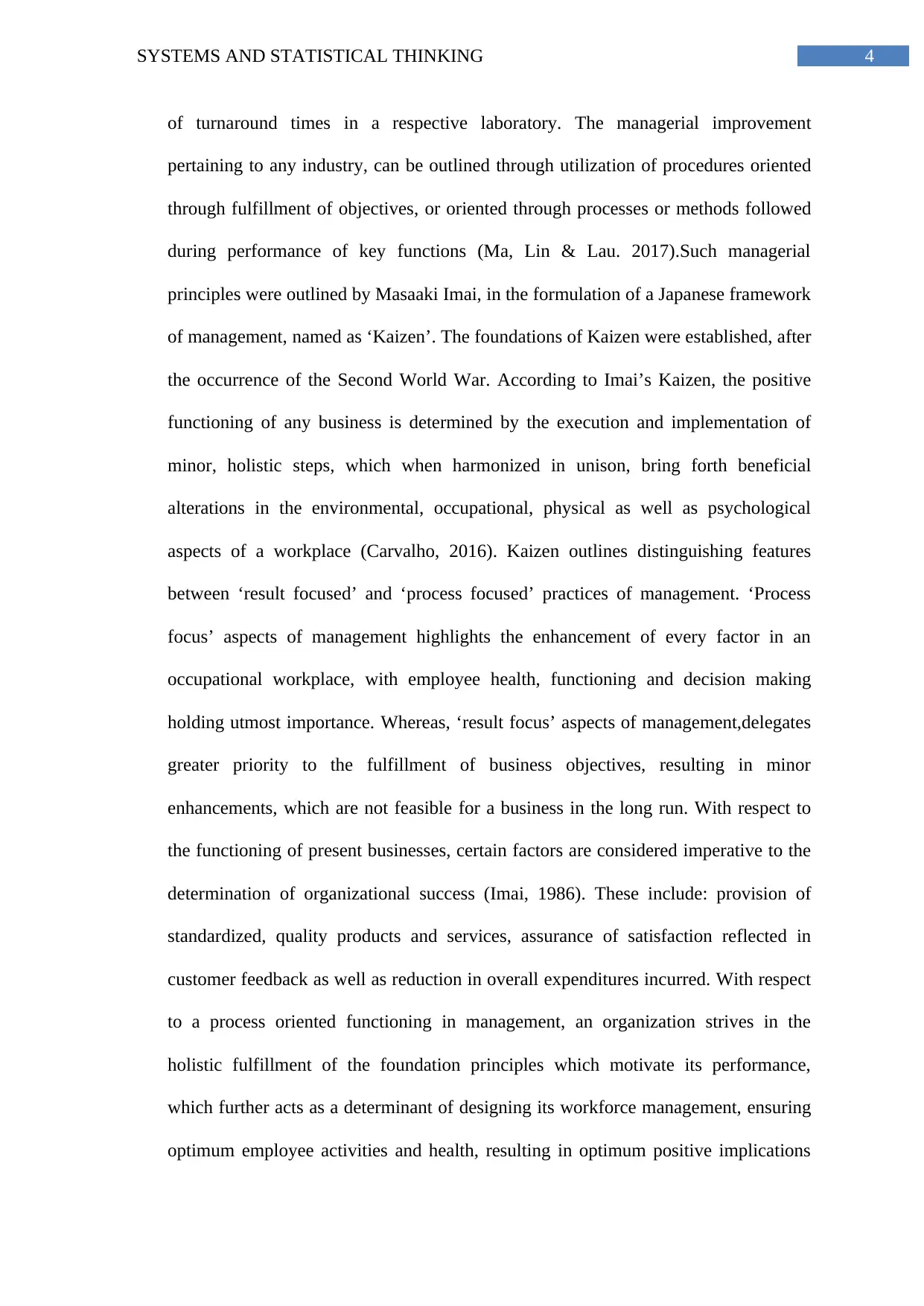
4SYSTEMS AND STATISTICAL THINKING
of turnaround times in a respective laboratory. The managerial improvement
pertaining to any industry, can be outlined through utilization of procedures oriented
through fulfillment of objectives, or oriented through processes or methods followed
during performance of key functions (Ma, Lin & Lau. 2017).Such managerial
principles were outlined by Masaaki Imai, in the formulation of a Japanese framework
of management, named as ‘Kaizen’. The foundations of Kaizen were established, after
the occurrence of the Second World War. According to Imai’s Kaizen, the positive
functioning of any business is determined by the execution and implementation of
minor, holistic steps, which when harmonized in unison, bring forth beneficial
alterations in the environmental, occupational, physical as well as psychological
aspects of a workplace (Carvalho, 2016). Kaizen outlines distinguishing features
between ‘result focused’ and ‘process focused’ practices of management. ‘Process
focus’ aspects of management highlights the enhancement of every factor in an
occupational workplace, with employee health, functioning and decision making
holding utmost importance. Whereas, ‘result focus’ aspects of management,delegates
greater priority to the fulfillment of business objectives, resulting in minor
enhancements, which are not feasible for a business in the long run. With respect to
the functioning of present businesses, certain factors are considered imperative to the
determination of organizational success (Imai, 1986). These include: provision of
standardized, quality products and services, assurance of satisfaction reflected in
customer feedback as well as reduction in overall expenditures incurred. With respect
to a process oriented functioning in management, an organization strives in the
holistic fulfillment of the foundation principles which motivate its performance,
which further acts as a determinant of designing its workforce management, ensuring
optimum employee activities and health, resulting in optimum positive implications
of turnaround times in a respective laboratory. The managerial improvement
pertaining to any industry, can be outlined through utilization of procedures oriented
through fulfillment of objectives, or oriented through processes or methods followed
during performance of key functions (Ma, Lin & Lau. 2017).Such managerial
principles were outlined by Masaaki Imai, in the formulation of a Japanese framework
of management, named as ‘Kaizen’. The foundations of Kaizen were established, after
the occurrence of the Second World War. According to Imai’s Kaizen, the positive
functioning of any business is determined by the execution and implementation of
minor, holistic steps, which when harmonized in unison, bring forth beneficial
alterations in the environmental, occupational, physical as well as psychological
aspects of a workplace (Carvalho, 2016). Kaizen outlines distinguishing features
between ‘result focused’ and ‘process focused’ practices of management. ‘Process
focus’ aspects of management highlights the enhancement of every factor in an
occupational workplace, with employee health, functioning and decision making
holding utmost importance. Whereas, ‘result focus’ aspects of management,delegates
greater priority to the fulfillment of business objectives, resulting in minor
enhancements, which are not feasible for a business in the long run. With respect to
the functioning of present businesses, certain factors are considered imperative to the
determination of organizational success (Imai, 1986). These include: provision of
standardized, quality products and services, assurance of satisfaction reflected in
customer feedback as well as reduction in overall expenditures incurred. With respect
to a process oriented functioning in management, an organization strives in the
holistic fulfillment of the foundation principles which motivate its performance,
which further acts as a determinant of designing its workforce management, ensuring
optimum employee activities and health, resulting in optimum positive implications
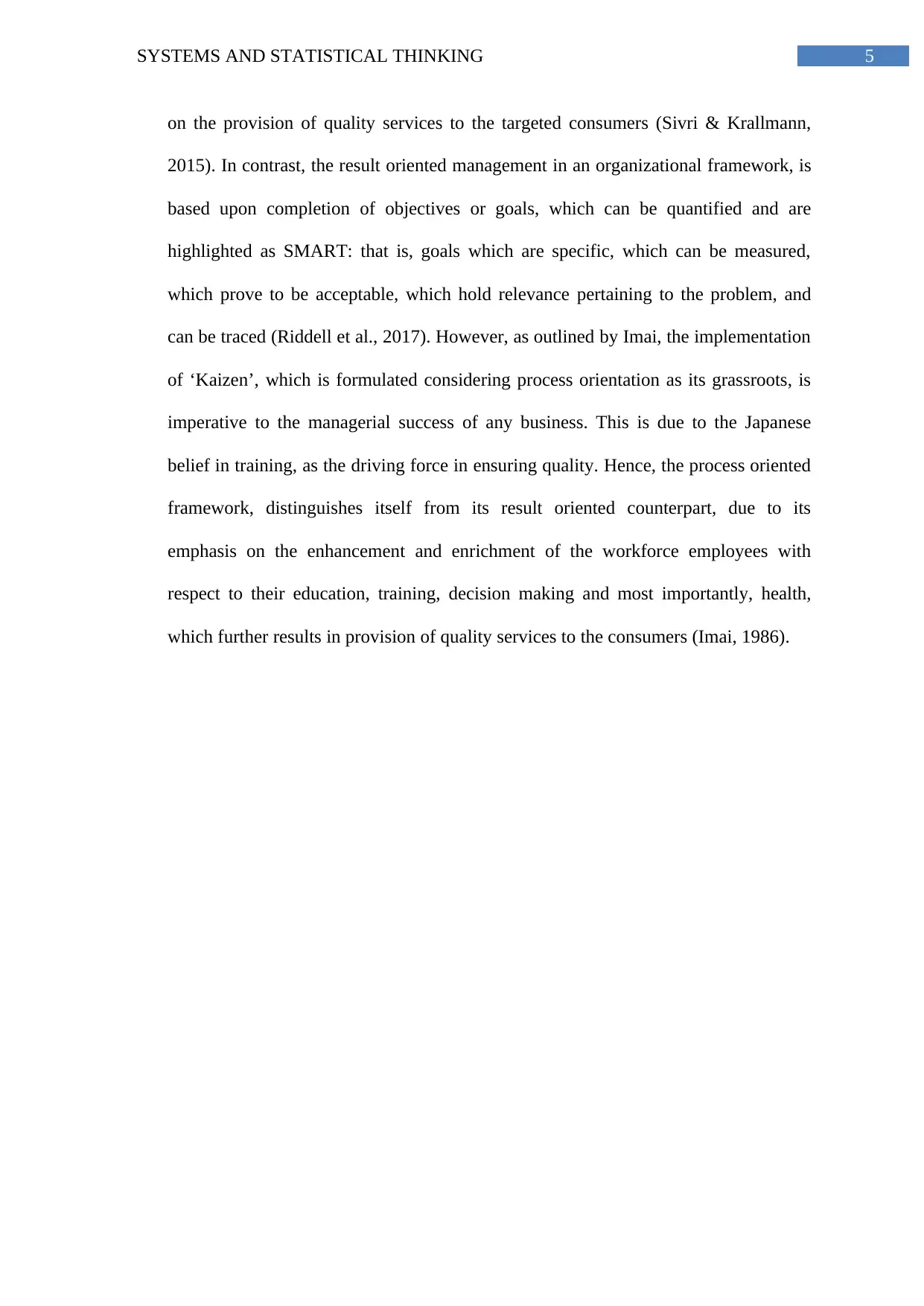
5SYSTEMS AND STATISTICAL THINKING
on the provision of quality services to the targeted consumers (Sivri & Krallmann,
2015). In contrast, the result oriented management in an organizational framework, is
based upon completion of objectives or goals, which can be quantified and are
highlighted as SMART: that is, goals which are specific, which can be measured,
which prove to be acceptable, which hold relevance pertaining to the problem, and
can be traced (Riddell et al., 2017). However, as outlined by Imai, the implementation
of ‘Kaizen’, which is formulated considering process orientation as its grassroots, is
imperative to the managerial success of any business. This is due to the Japanese
belief in training, as the driving force in ensuring quality. Hence, the process oriented
framework, distinguishes itself from its result oriented counterpart, due to its
emphasis on the enhancement and enrichment of the workforce employees with
respect to their education, training, decision making and most importantly, health,
which further results in provision of quality services to the consumers (Imai, 1986).
on the provision of quality services to the targeted consumers (Sivri & Krallmann,
2015). In contrast, the result oriented management in an organizational framework, is
based upon completion of objectives or goals, which can be quantified and are
highlighted as SMART: that is, goals which are specific, which can be measured,
which prove to be acceptable, which hold relevance pertaining to the problem, and
can be traced (Riddell et al., 2017). However, as outlined by Imai, the implementation
of ‘Kaizen’, which is formulated considering process orientation as its grassroots, is
imperative to the managerial success of any business. This is due to the Japanese
belief in training, as the driving force in ensuring quality. Hence, the process oriented
framework, distinguishes itself from its result oriented counterpart, due to its
emphasis on the enhancement and enrichment of the workforce employees with
respect to their education, training, decision making and most importantly, health,
which further results in provision of quality services to the consumers (Imai, 1986).
⊘ This is a preview!⊘
Do you want full access?
Subscribe today to unlock all pages.

Trusted by 1+ million students worldwide
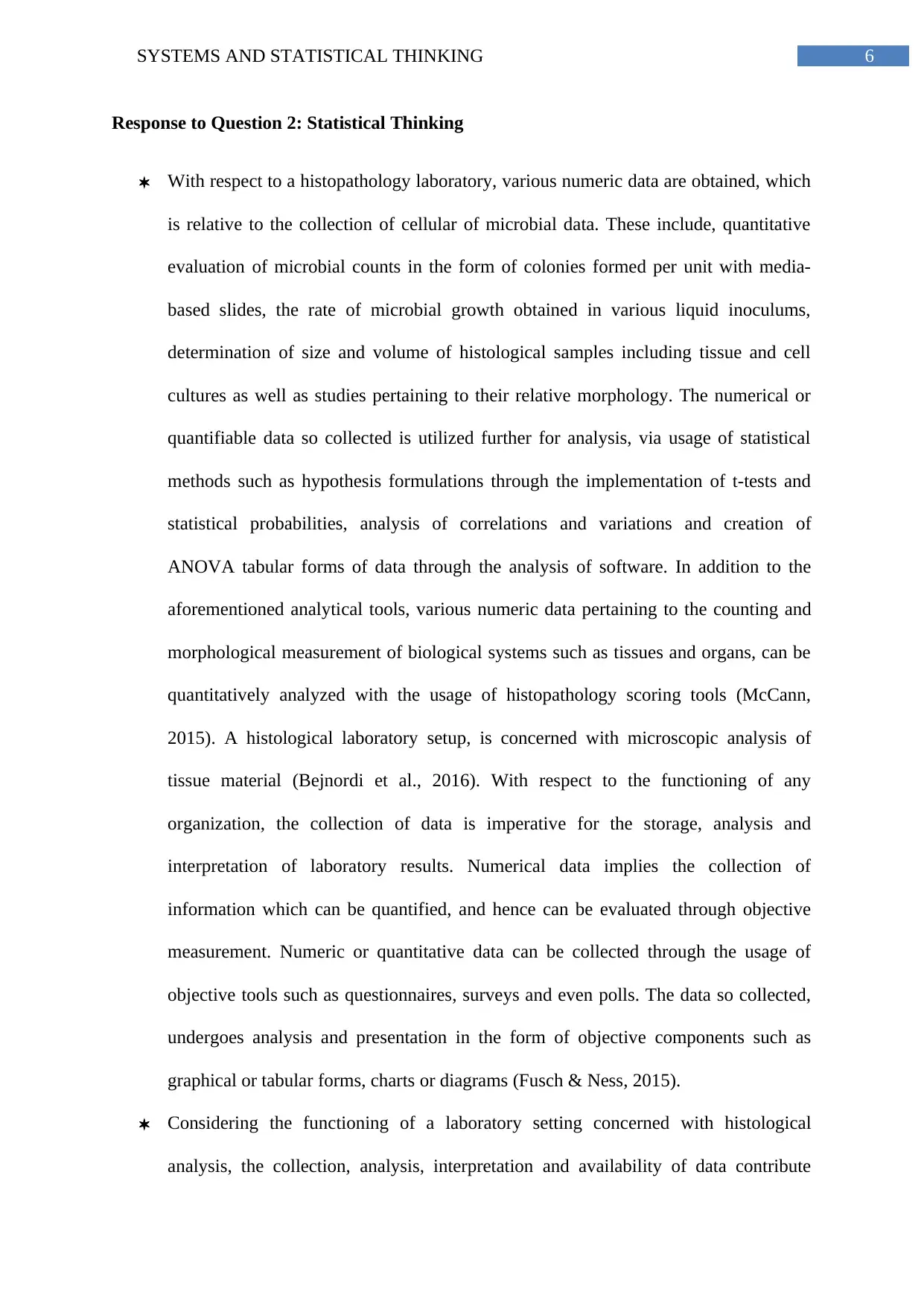
6SYSTEMS AND STATISTICAL THINKING
Response to Question 2: Statistical Thinking
With respect to a histopathology laboratory, various numeric data are obtained, which
is relative to the collection of cellular of microbial data. These include, quantitative
evaluation of microbial counts in the form of colonies formed per unit with media-
based slides, the rate of microbial growth obtained in various liquid inoculums,
determination of size and volume of histological samples including tissue and cell
cultures as well as studies pertaining to their relative morphology. The numerical or
quantifiable data so collected is utilized further for analysis, via usage of statistical
methods such as hypothesis formulations through the implementation of t-tests and
statistical probabilities, analysis of correlations and variations and creation of
ANOVA tabular forms of data through the analysis of software. In addition to the
aforementioned analytical tools, various numeric data pertaining to the counting and
morphological measurement of biological systems such as tissues and organs, can be
quantitatively analyzed with the usage of histopathology scoring tools (McCann,
2015). A histological laboratory setup, is concerned with microscopic analysis of
tissue material (Bejnordi et al., 2016). With respect to the functioning of any
organization, the collection of data is imperative for the storage, analysis and
interpretation of laboratory results. Numerical data implies the collection of
information which can be quantified, and hence can be evaluated through objective
measurement. Numeric or quantitative data can be collected through the usage of
objective tools such as questionnaires, surveys and even polls. The data so collected,
undergoes analysis and presentation in the form of objective components such as
graphical or tabular forms, charts or diagrams (Fusch & Ness, 2015).
Considering the functioning of a laboratory setting concerned with histological
analysis, the collection, analysis, interpretation and availability of data contribute
Response to Question 2: Statistical Thinking
With respect to a histopathology laboratory, various numeric data are obtained, which
is relative to the collection of cellular of microbial data. These include, quantitative
evaluation of microbial counts in the form of colonies formed per unit with media-
based slides, the rate of microbial growth obtained in various liquid inoculums,
determination of size and volume of histological samples including tissue and cell
cultures as well as studies pertaining to their relative morphology. The numerical or
quantifiable data so collected is utilized further for analysis, via usage of statistical
methods such as hypothesis formulations through the implementation of t-tests and
statistical probabilities, analysis of correlations and variations and creation of
ANOVA tabular forms of data through the analysis of software. In addition to the
aforementioned analytical tools, various numeric data pertaining to the counting and
morphological measurement of biological systems such as tissues and organs, can be
quantitatively analyzed with the usage of histopathology scoring tools (McCann,
2015). A histological laboratory setup, is concerned with microscopic analysis of
tissue material (Bejnordi et al., 2016). With respect to the functioning of any
organization, the collection of data is imperative for the storage, analysis and
interpretation of laboratory results. Numerical data implies the collection of
information which can be quantified, and hence can be evaluated through objective
measurement. Numeric or quantitative data can be collected through the usage of
objective tools such as questionnaires, surveys and even polls. The data so collected,
undergoes analysis and presentation in the form of objective components such as
graphical or tabular forms, charts or diagrams (Fusch & Ness, 2015).
Considering the functioning of a laboratory setting concerned with histological
analysis, the collection, analysis, interpretation and availability of data contribute
Paraphrase This Document
Need a fresh take? Get an instant paraphrase of this document with our AI Paraphraser
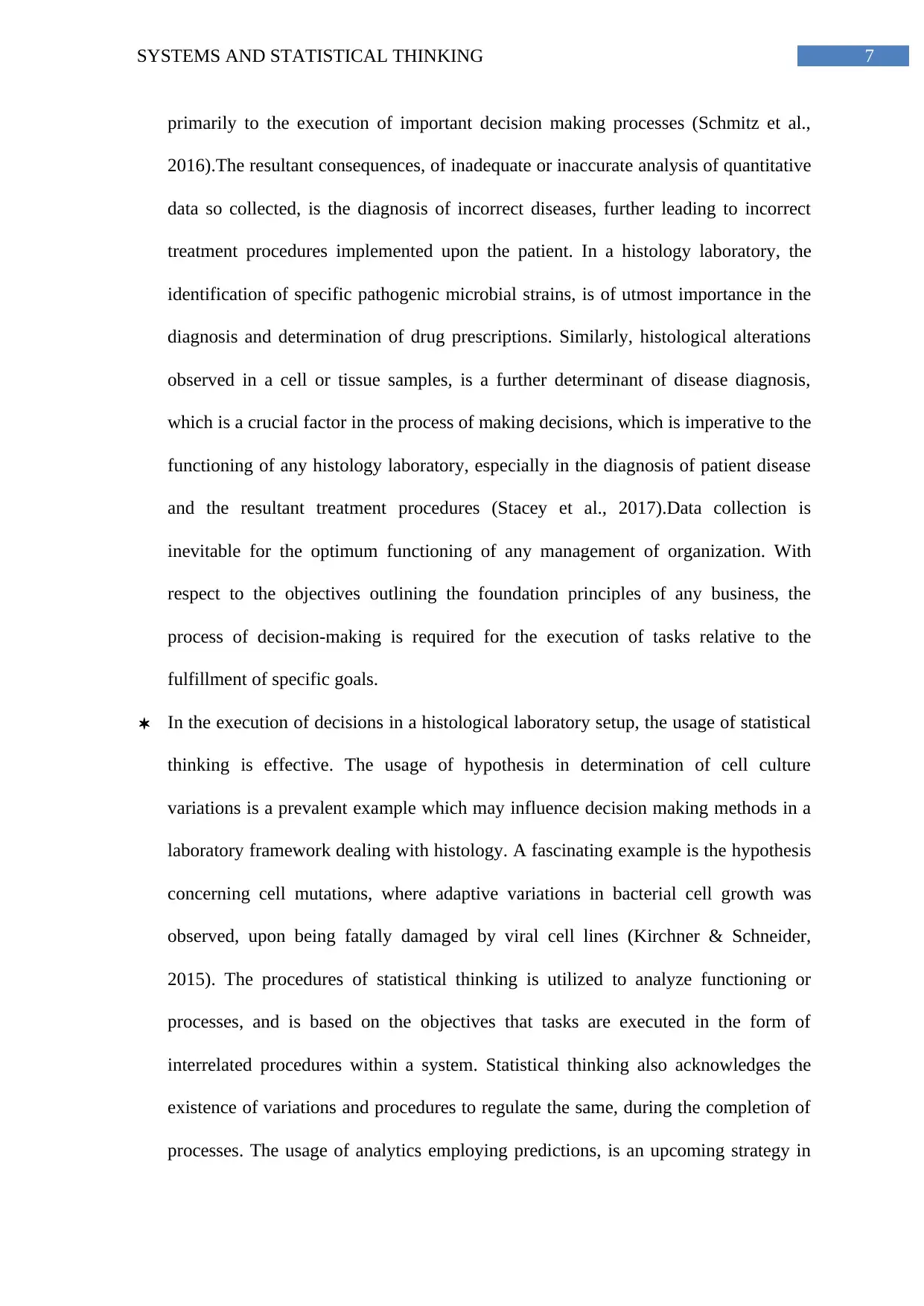
7SYSTEMS AND STATISTICAL THINKING
primarily to the execution of important decision making processes (Schmitz et al.,
2016).The resultant consequences, of inadequate or inaccurate analysis of quantitative
data so collected, is the diagnosis of incorrect diseases, further leading to incorrect
treatment procedures implemented upon the patient. In a histology laboratory, the
identification of specific pathogenic microbial strains, is of utmost importance in the
diagnosis and determination of drug prescriptions. Similarly, histological alterations
observed in a cell or tissue samples, is a further determinant of disease diagnosis,
which is a crucial factor in the process of making decisions, which is imperative to the
functioning of any histology laboratory, especially in the diagnosis of patient disease
and the resultant treatment procedures (Stacey et al., 2017).Data collection is
inevitable for the optimum functioning of any management of organization. With
respect to the objectives outlining the foundation principles of any business, the
process of decision-making is required for the execution of tasks relative to the
fulfillment of specific goals.
In the execution of decisions in a histological laboratory setup, the usage of statistical
thinking is effective. The usage of hypothesis in determination of cell culture
variations is a prevalent example which may influence decision making methods in a
laboratory framework dealing with histology. A fascinating example is the hypothesis
concerning cell mutations, where adaptive variations in bacterial cell growth was
observed, upon being fatally damaged by viral cell lines (Kirchner & Schneider,
2015). The procedures of statistical thinking is utilized to analyze functioning or
processes, and is based on the objectives that tasks are executed in the form of
interrelated procedures within a system. Statistical thinking also acknowledges the
existence of variations and procedures to regulate the same, during the completion of
processes. The usage of analytics employing predictions, is an upcoming strategy in
primarily to the execution of important decision making processes (Schmitz et al.,
2016).The resultant consequences, of inadequate or inaccurate analysis of quantitative
data so collected, is the diagnosis of incorrect diseases, further leading to incorrect
treatment procedures implemented upon the patient. In a histology laboratory, the
identification of specific pathogenic microbial strains, is of utmost importance in the
diagnosis and determination of drug prescriptions. Similarly, histological alterations
observed in a cell or tissue samples, is a further determinant of disease diagnosis,
which is a crucial factor in the process of making decisions, which is imperative to the
functioning of any histology laboratory, especially in the diagnosis of patient disease
and the resultant treatment procedures (Stacey et al., 2017).Data collection is
inevitable for the optimum functioning of any management of organization. With
respect to the objectives outlining the foundation principles of any business, the
process of decision-making is required for the execution of tasks relative to the
fulfillment of specific goals.
In the execution of decisions in a histological laboratory setup, the usage of statistical
thinking is effective. The usage of hypothesis in determination of cell culture
variations is a prevalent example which may influence decision making methods in a
laboratory framework dealing with histology. A fascinating example is the hypothesis
concerning cell mutations, where adaptive variations in bacterial cell growth was
observed, upon being fatally damaged by viral cell lines (Kirchner & Schneider,
2015). The procedures of statistical thinking is utilized to analyze functioning or
processes, and is based on the objectives that tasks are executed in the form of
interrelated procedures within a system. Statistical thinking also acknowledges the
existence of variations and procedures to regulate the same, during the completion of
processes. The usage of analytics employing predictions, is an upcoming strategy in
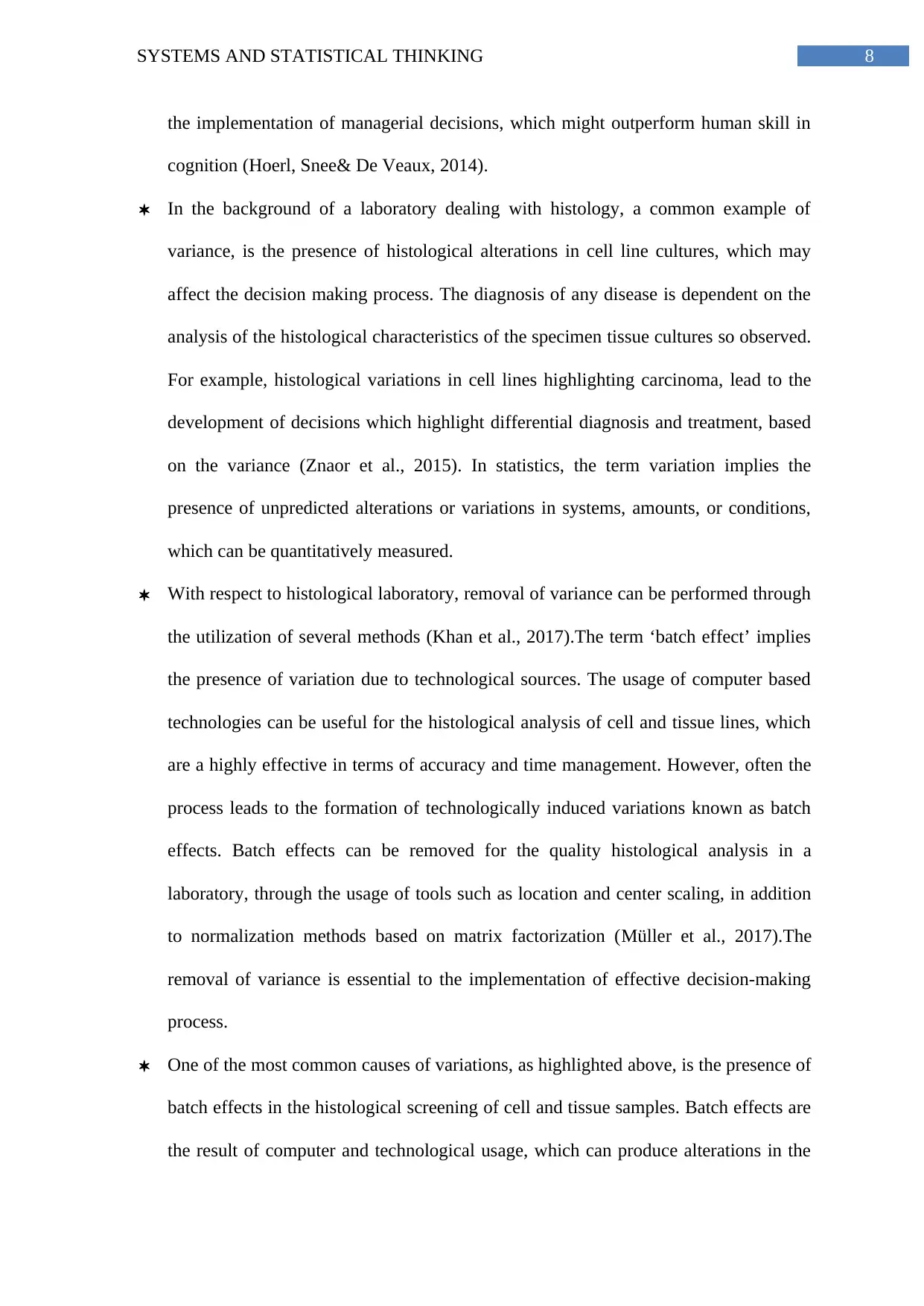
8SYSTEMS AND STATISTICAL THINKING
the implementation of managerial decisions, which might outperform human skill in
cognition (Hoerl, Snee& De Veaux, 2014).
In the background of a laboratory dealing with histology, a common example of
variance, is the presence of histological alterations in cell line cultures, which may
affect the decision making process. The diagnosis of any disease is dependent on the
analysis of the histological characteristics of the specimen tissue cultures so observed.
For example, histological variations in cell lines highlighting carcinoma, lead to the
development of decisions which highlight differential diagnosis and treatment, based
on the variance (Znaor et al., 2015). In statistics, the term variation implies the
presence of unpredicted alterations or variations in systems, amounts, or conditions,
which can be quantitatively measured.
With respect to histological laboratory, removal of variance can be performed through
the utilization of several methods (Khan et al., 2017).The term ‘batch effect’ implies
the presence of variation due to technological sources. The usage of computer based
technologies can be useful for the histological analysis of cell and tissue lines, which
are a highly effective in terms of accuracy and time management. However, often the
process leads to the formation of technologically induced variations known as batch
effects. Batch effects can be removed for the quality histological analysis in a
laboratory, through the usage of tools such as location and center scaling, in addition
to normalization methods based on matrix factorization (Müller et al., 2017).The
removal of variance is essential to the implementation of effective decision-making
process.
One of the most common causes of variations, as highlighted above, is the presence of
batch effects in the histological screening of cell and tissue samples. Batch effects are
the result of computer and technological usage, which can produce alterations in the
the implementation of managerial decisions, which might outperform human skill in
cognition (Hoerl, Snee& De Veaux, 2014).
In the background of a laboratory dealing with histology, a common example of
variance, is the presence of histological alterations in cell line cultures, which may
affect the decision making process. The diagnosis of any disease is dependent on the
analysis of the histological characteristics of the specimen tissue cultures so observed.
For example, histological variations in cell lines highlighting carcinoma, lead to the
development of decisions which highlight differential diagnosis and treatment, based
on the variance (Znaor et al., 2015). In statistics, the term variation implies the
presence of unpredicted alterations or variations in systems, amounts, or conditions,
which can be quantitatively measured.
With respect to histological laboratory, removal of variance can be performed through
the utilization of several methods (Khan et al., 2017).The term ‘batch effect’ implies
the presence of variation due to technological sources. The usage of computer based
technologies can be useful for the histological analysis of cell and tissue lines, which
are a highly effective in terms of accuracy and time management. However, often the
process leads to the formation of technologically induced variations known as batch
effects. Batch effects can be removed for the quality histological analysis in a
laboratory, through the usage of tools such as location and center scaling, in addition
to normalization methods based on matrix factorization (Müller et al., 2017).The
removal of variance is essential to the implementation of effective decision-making
process.
One of the most common causes of variations, as highlighted above, is the presence of
batch effects in the histological screening of cell and tissue samples. Batch effects are
the result of computer and technological usage, which can produce alterations in the
⊘ This is a preview!⊘
Do you want full access?
Subscribe today to unlock all pages.

Trusted by 1+ million students worldwide
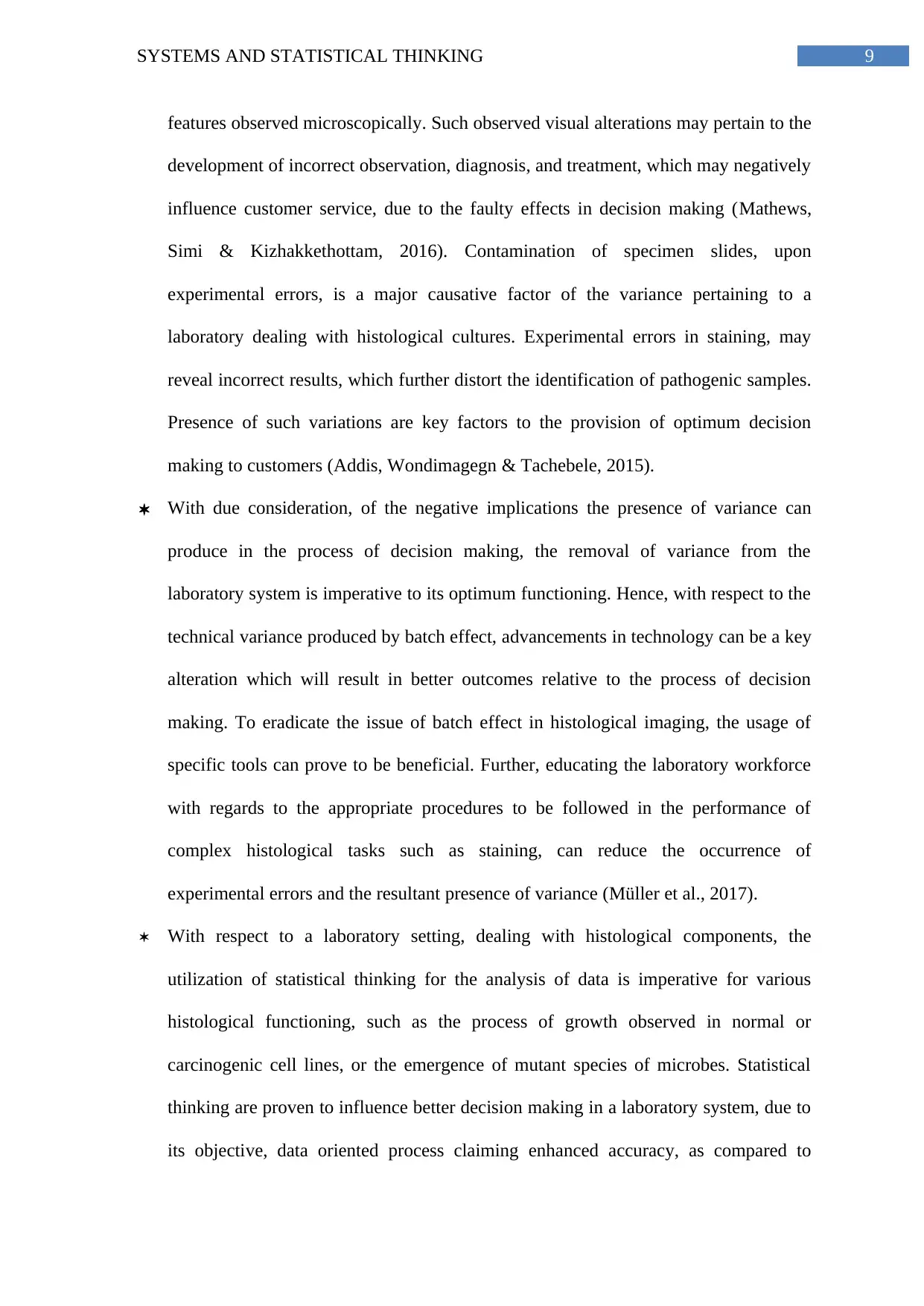
9SYSTEMS AND STATISTICAL THINKING
features observed microscopically. Such observed visual alterations may pertain to the
development of incorrect observation, diagnosis, and treatment, which may negatively
influence customer service, due to the faulty effects in decision making (Mathews,
Simi & Kizhakkethottam, 2016). Contamination of specimen slides, upon
experimental errors, is a major causative factor of the variance pertaining to a
laboratory dealing with histological cultures. Experimental errors in staining, may
reveal incorrect results, which further distort the identification of pathogenic samples.
Presence of such variations are key factors to the provision of optimum decision
making to customers (Addis, Wondimagegn & Tachebele, 2015).
With due consideration, of the negative implications the presence of variance can
produce in the process of decision making, the removal of variance from the
laboratory system is imperative to its optimum functioning. Hence, with respect to the
technical variance produced by batch effect, advancements in technology can be a key
alteration which will result in better outcomes relative to the process of decision
making. To eradicate the issue of batch effect in histological imaging, the usage of
specific tools can prove to be beneficial. Further, educating the laboratory workforce
with regards to the appropriate procedures to be followed in the performance of
complex histological tasks such as staining, can reduce the occurrence of
experimental errors and the resultant presence of variance (Müller et al., 2017).
With respect to a laboratory setting, dealing with histological components, the
utilization of statistical thinking for the analysis of data is imperative for various
histological functioning, such as the process of growth observed in normal or
carcinogenic cell lines, or the emergence of mutant species of microbes. Statistical
thinking are proven to influence better decision making in a laboratory system, due to
its objective, data oriented process claiming enhanced accuracy, as compared to
features observed microscopically. Such observed visual alterations may pertain to the
development of incorrect observation, diagnosis, and treatment, which may negatively
influence customer service, due to the faulty effects in decision making (Mathews,
Simi & Kizhakkethottam, 2016). Contamination of specimen slides, upon
experimental errors, is a major causative factor of the variance pertaining to a
laboratory dealing with histological cultures. Experimental errors in staining, may
reveal incorrect results, which further distort the identification of pathogenic samples.
Presence of such variations are key factors to the provision of optimum decision
making to customers (Addis, Wondimagegn & Tachebele, 2015).
With due consideration, of the negative implications the presence of variance can
produce in the process of decision making, the removal of variance from the
laboratory system is imperative to its optimum functioning. Hence, with respect to the
technical variance produced by batch effect, advancements in technology can be a key
alteration which will result in better outcomes relative to the process of decision
making. To eradicate the issue of batch effect in histological imaging, the usage of
specific tools can prove to be beneficial. Further, educating the laboratory workforce
with regards to the appropriate procedures to be followed in the performance of
complex histological tasks such as staining, can reduce the occurrence of
experimental errors and the resultant presence of variance (Müller et al., 2017).
With respect to a laboratory setting, dealing with histological components, the
utilization of statistical thinking for the analysis of data is imperative for various
histological functioning, such as the process of growth observed in normal or
carcinogenic cell lines, or the emergence of mutant species of microbes. Statistical
thinking are proven to influence better decision making in a laboratory system, due to
its objective, data oriented process claiming enhanced accuracy, as compared to
Paraphrase This Document
Need a fresh take? Get an instant paraphrase of this document with our AI Paraphraser
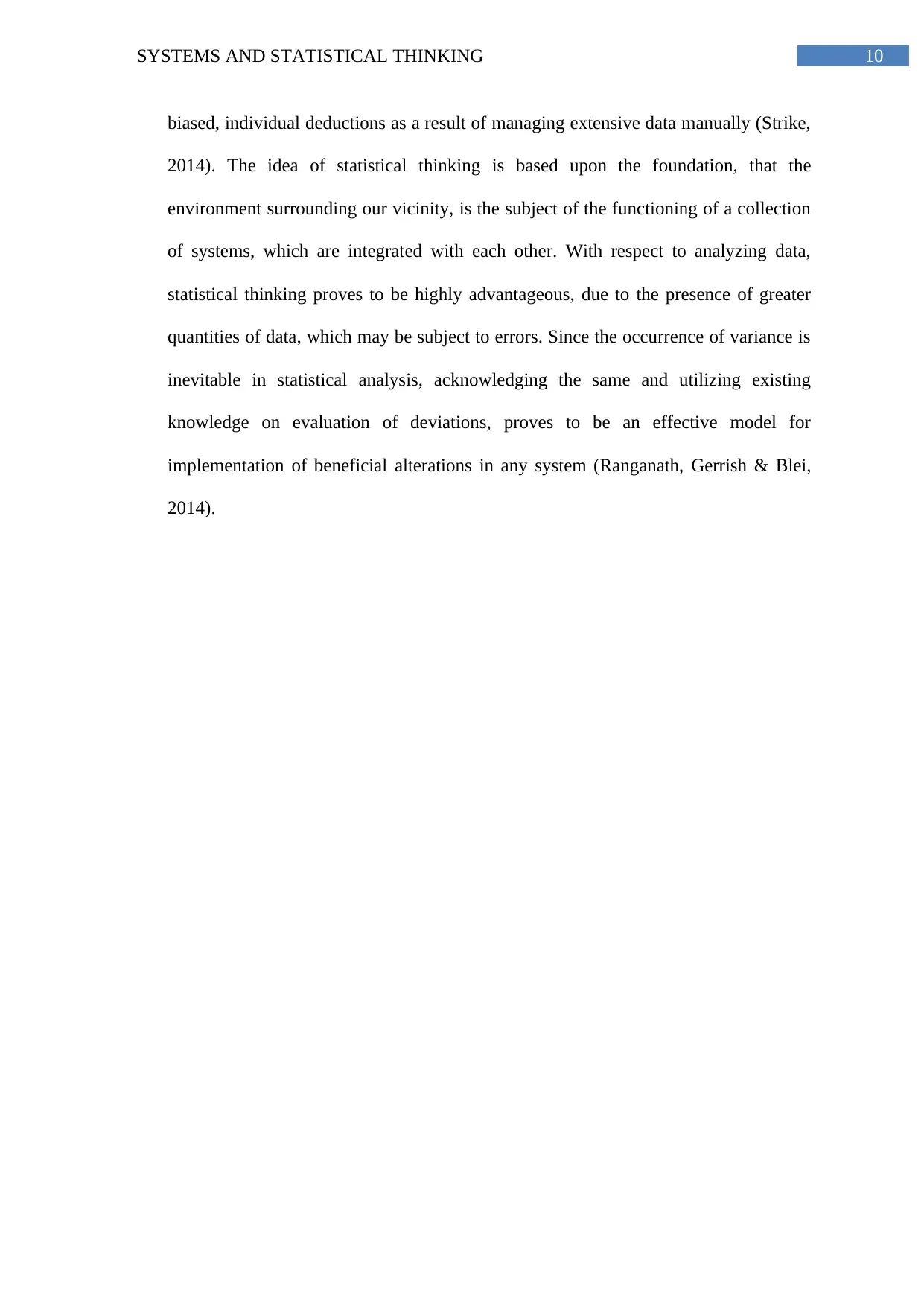
10SYSTEMS AND STATISTICAL THINKING
biased, individual deductions as a result of managing extensive data manually (Strike,
2014). The idea of statistical thinking is based upon the foundation, that the
environment surrounding our vicinity, is the subject of the functioning of a collection
of systems, which are integrated with each other. With respect to analyzing data,
statistical thinking proves to be highly advantageous, due to the presence of greater
quantities of data, which may be subject to errors. Since the occurrence of variance is
inevitable in statistical analysis, acknowledging the same and utilizing existing
knowledge on evaluation of deviations, proves to be an effective model for
implementation of beneficial alterations in any system (Ranganath, Gerrish & Blei,
2014).
biased, individual deductions as a result of managing extensive data manually (Strike,
2014). The idea of statistical thinking is based upon the foundation, that the
environment surrounding our vicinity, is the subject of the functioning of a collection
of systems, which are integrated with each other. With respect to analyzing data,
statistical thinking proves to be highly advantageous, due to the presence of greater
quantities of data, which may be subject to errors. Since the occurrence of variance is
inevitable in statistical analysis, acknowledging the same and utilizing existing
knowledge on evaluation of deviations, proves to be an effective model for
implementation of beneficial alterations in any system (Ranganath, Gerrish & Blei,
2014).
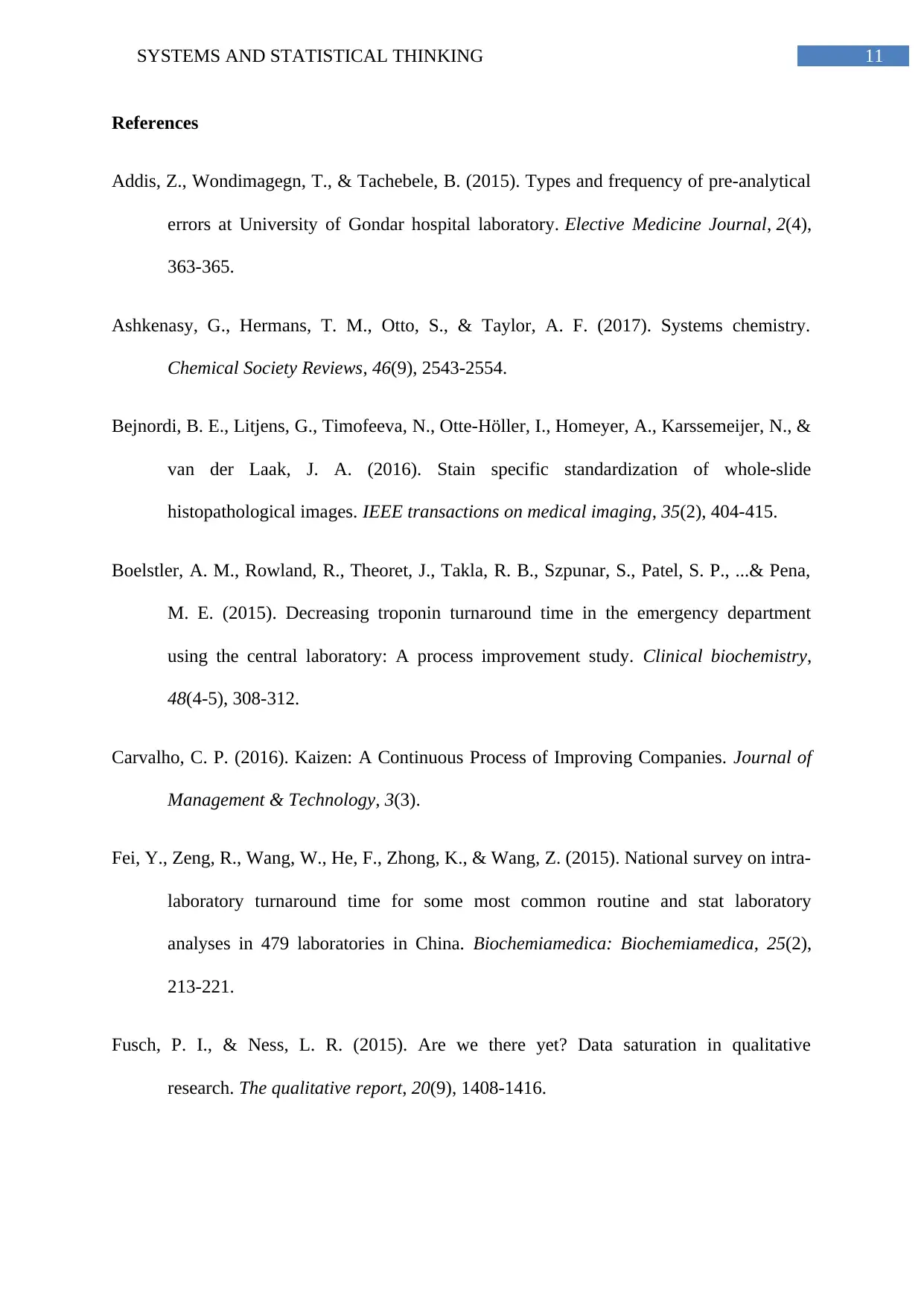
11SYSTEMS AND STATISTICAL THINKING
References
Addis, Z., Wondimagegn, T., & Tachebele, B. (2015). Types and frequency of pre-analytical
errors at University of Gondar hospital laboratory. Elective Medicine Journal, 2(4),
363-365.
Ashkenasy, G., Hermans, T. M., Otto, S., & Taylor, A. F. (2017). Systems chemistry.
Chemical Society Reviews, 46(9), 2543-2554.
Bejnordi, B. E., Litjens, G., Timofeeva, N., Otte-Höller, I., Homeyer, A., Karssemeijer, N., &
van der Laak, J. A. (2016). Stain specific standardization of whole-slide
histopathological images. IEEE transactions on medical imaging, 35(2), 404-415.
Boelstler, A. M., Rowland, R., Theoret, J., Takla, R. B., Szpunar, S., Patel, S. P., ...& Pena,
M. E. (2015). Decreasing troponin turnaround time in the emergency department
using the central laboratory: A process improvement study. Clinical biochemistry,
48(4-5), 308-312.
Carvalho, C. P. (2016). Kaizen: A Continuous Process of Improving Companies. Journal of
Management & Technology, 3(3).
Fei, Y., Zeng, R., Wang, W., He, F., Zhong, K., & Wang, Z. (2015). National survey on intra-
laboratory turnaround time for some most common routine and stat laboratory
analyses in 479 laboratories in China. Biochemiamedica: Biochemiamedica, 25(2),
213-221.
Fusch, P. I., & Ness, L. R. (2015). Are we there yet? Data saturation in qualitative
research. The qualitative report, 20(9), 1408-1416.
References
Addis, Z., Wondimagegn, T., & Tachebele, B. (2015). Types and frequency of pre-analytical
errors at University of Gondar hospital laboratory. Elective Medicine Journal, 2(4),
363-365.
Ashkenasy, G., Hermans, T. M., Otto, S., & Taylor, A. F. (2017). Systems chemistry.
Chemical Society Reviews, 46(9), 2543-2554.
Bejnordi, B. E., Litjens, G., Timofeeva, N., Otte-Höller, I., Homeyer, A., Karssemeijer, N., &
van der Laak, J. A. (2016). Stain specific standardization of whole-slide
histopathological images. IEEE transactions on medical imaging, 35(2), 404-415.
Boelstler, A. M., Rowland, R., Theoret, J., Takla, R. B., Szpunar, S., Patel, S. P., ...& Pena,
M. E. (2015). Decreasing troponin turnaround time in the emergency department
using the central laboratory: A process improvement study. Clinical biochemistry,
48(4-5), 308-312.
Carvalho, C. P. (2016). Kaizen: A Continuous Process of Improving Companies. Journal of
Management & Technology, 3(3).
Fei, Y., Zeng, R., Wang, W., He, F., Zhong, K., & Wang, Z. (2015). National survey on intra-
laboratory turnaround time for some most common routine and stat laboratory
analyses in 479 laboratories in China. Biochemiamedica: Biochemiamedica, 25(2),
213-221.
Fusch, P. I., & Ness, L. R. (2015). Are we there yet? Data saturation in qualitative
research. The qualitative report, 20(9), 1408-1416.
⊘ This is a preview!⊘
Do you want full access?
Subscribe today to unlock all pages.

Trusted by 1+ million students worldwide
1 out of 16
Your All-in-One AI-Powered Toolkit for Academic Success.
+13062052269
info@desklib.com
Available 24*7 on WhatsApp / Email
![[object Object]](/_next/static/media/star-bottom.7253800d.svg)
Unlock your academic potential
Copyright © 2020–2025 A2Z Services. All Rights Reserved. Developed and managed by ZUCOL.
